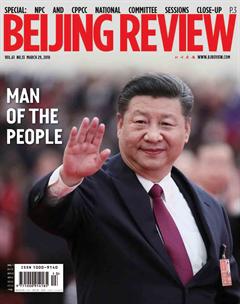Will Big Cabinet Changes Lead to Big Societal Changes?
By Josef Gregory Mahoney

One of the central concepts in Chinese philosophy is the perpetuity of change, and as a great number of scholars have pointed out, it is an extraordinary capacity for change, even radically when necessary, that is the hallmark of the political system of the Peoples Republic of China.
The 18th National Congress of the Communist Party of China (CPC) in 2012 saw the election of Xi Jinping as general secretary of the Partys Central Committee and a new generation of the Partys leadership with a mandate for new reforms. That same year, a widely discussed book by Pierre Landry illustrated how the Party had successfully empowered local governments to improve development and governance while nevertheless maintaining effective central control.
Scholars found another trend: the proliferation of ministries and bureaus at local and national levels that could at times be at odds with each other. Some of these tensions were seen as positive, for example ecological protection versus commerce and energy, which in some cases provided offi cial pushback against national plans that might have undermined environmental protection. But they also ran the risk of increasing confusion, red tape and inaction in both government and society.
Reforms launched at the 19th CPC National Congress in October 2017 and follow-up meetings, including the Third Plenary Session of the 19th CPC Central Committee and the First Session of the 13th National Peoples Congress(NPC), Chinas top legislature, have endorsed a major reshuffl e of cabinet-level portfolios. While the Party has made it clear that it will continue to empower local governance, it will also better supervise it institutionally.
According to an institutional restructuring plan approved by the NPC, the State Council, Chinas cabinet, will now consist of 26 ministries and commissions. The number of ministeriallevel entities will be reduced by eight, while those at the vice-ministerial level will drop by seven after the reshuffle, producing in some cases what have been described unofficially as “super ministries.” These include ministries devoted to health, ecological and environment protection, culture and tourism, and agriculture and rural affairs, among others. The stated aim is to create more coherent approaches to policymaking and regulation, thereby improving governance related to economic management, market supervision, social management, public service and ecological and environmental protection.
On the one hand, these reforms present as logical steps forward, as they straight away aim to reconcile differences that inevitably arise in regulation, oversight and development. Such problems are present in even the most advanced countries, and Chinas system has certainly not yet reached the pinnacle of such development, as President Xi Jinping has made clear in two lengthy published volumes discussing the need to reform Chinas governance.
At the same time, such reforms always accompany a fast-developing society and economy like Chinas. Additionally, the Chinese political system requires a certain amount of centralization, otherwise it might stumble into unmanageable disarray while providing poor service. Therefore, in some cases, recentralization can serve as a type of renewal, particularly in a new era that is marching to the tune set by changing conditions and needs.
On the other hand, looking at Chinas long history and comparing it with others, no other country has proven a greater civilizational capacity to over-bureaucratize, frequently to the point of self-paralysis with respect to the ability to advance meaningful reforms and progress. While these reforms aim to correct this tendency in part, they do so by streamlining to increase and improve oversight in lieu of increasing decentralization and even, deregulation, i.e. the sort of reform remedies that historically have tended to track more closely with increasing marketization.
There will be at least three major challenges going forward. First, one of the advantages of previous “looseness” is that it allowed for some fl exibility that, in turn, empowered change and development, particularly given differences that affect China by locality.
Second, will then better-centralized governance ultimately disempower local governance, contrary to aims at advancing it? In short, how will the new system retain the positive consequences of such flexibility and local empowerment while mitigating the possible negative outcomes? Additionally, do so-called“super-ministries” risk becoming bureaucratic monoliths? In both cases, effi ciencies and economies of scale can become reductive to the point of vitiating their advantages. Furthermore, some analysts have pointed to this as a problem that can make the middle-income trap more likely to occur, which China has been determined to avoid.
In effect, the status quo becomes institutionalized and resistant to change because of the growing layers of rules and laws with an increasingly all-encompassing scope. As new problems emerge, they become systemic to the point where the system is incapable of adjustments or reforms because the system itself is complicit. This has been described as a problem which Japan is facing, for example. Somewhat similarly, Wang Huning, a member of the Standing Committee of the Political Bureau of the CPC Central Committee, described a polarizing incapacity for substantial reforms in the United States in his book, America Against America, an analysis that some would argue has stood the test of time.

